


Tube Theory - "ODE" to ElectronicsThe "Ode to Electronics" would have to be the vacuum tube. This is because you will learn lots of "odes" in tube theory: Electrodes, Diodes, Triodes, Tetrodes, and Pentodes, just to name a few. Before we go too far, we'll have to learn what an electrode is: An Electrode is a conductor which permits current to flow. Remember Frankenstein's Laboratory? It had the two round balls with the high voltage applied, and you saw the electricity arcing across from one ball to the other? These were electrodes, and they allowed current to flow from one ball to the other through the air. Electrodes are always used in pairs. You could say that the big alligator clamps on your automobiles jumper cables are electrodes, as are the little pads the doctor puts on your chest when he hooks you up to an EKG. Although I'd rather that the doctor use the little pads than the jumper cables! In tubes, the electrodes are elements within the vacuum which emit, collect or control the flow of current within the tube. The simplest of tubes has only 2 elements: The Cathode, and the Anode. 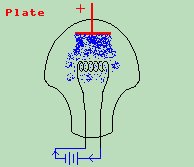 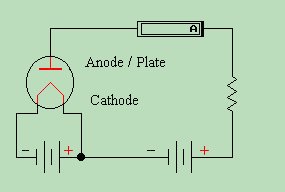 Looking at the pictures above, the picture on the left is a graphical representation of a "diode" or 2 element tube. It has a CATHODE (K), which emits electrons, and an ANODE (A), otherwise known as a PLATE (P), which collects the emitted electrons, allowing current to flow. The picture on the right is a schematic representation of the same. The circle represents the glass envelope, and the elements are contained within. The Cathode shown here looks like an inverted "V", and the Plate looks like, well, a flat "plate" of metal. What you see in the schematic on the right above is actually two circuits combined. We will now break these two circuits down, to simplify and show what is happening in each circuit. Keep in mind that there are multiple theories on the flow of electricity. We will use the electron theory (negative to positive) first to describe how current flows through the tube. However, whenever describing how power gets to the tube, it may sometimes be easier to think in terms of conventional flow from positive to negative. 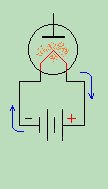 In the schematic to the left, arrows show the flow of electrons from the negative battery terminal, through the cathode of the tube, and back to the positive terminal of the battery to complete the circuit. The cathode gets red hot and glows. It gets so hot, that some of the electrons are thermionically emitted into the vacuum space directly around it, as shown by the little specks in the picture.
In the schematic to the left, arrows show the flow of electrons from the negative battery terminal, through the cathode of the tube, and back to the positive terminal of the battery to complete the circuit. The cathode gets red hot and glows. It gets so hot, that some of the electrons are thermionically emitted into the vacuum space directly around it, as shown by the little specks in the picture.The Cathode, in this case, is directly heated by the high flow of electron current through it. An electrode which is directly heated in this manner is also called a heater or filament. Not all filaments or heaters are cathodes, and not all cathodes are heaters or filaments. When a cathode is DIRECTLY heated, as this one is, then it is a heater / filament / cathode. Otherwise, tubes may have separate heaters & cathodes, in which case we say the cathode is INDIRECTLY heated. Below are illustrations of both types of cathodes, so that you may understand them better. 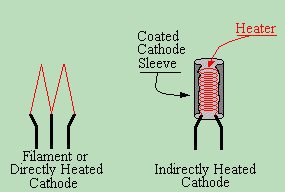
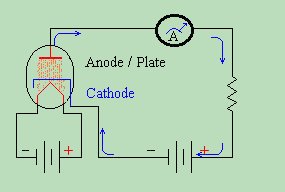 As you can see from the schematic diagram, the circuit operates in the same manner, except the heater is separate from the cathode. This is done for several reasons, including increased reliability and longer life, less interference between signal and power supply stages, lower resistance, higher frequencies can be obtained, and ease of design. 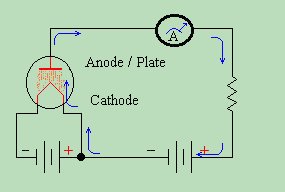 Understanding the left side of the schematic gives us some insight to what happens when we apply voltage to the plate.
Understanding the left side of the schematic gives us some insight to what happens when we apply voltage to the plate. By applying a positive voltage to the plate, a current can be observed on the Current Meter ( also called an Ammeter ), indicating that the circuit is complete between the two terminals of the battery. So by the indication of current flow on the Ammeter, we can assume that there is a complete loop formed via the plate! The electrons leave the negative side of the battery, and are emitted by the cathode of the tube. They are then collected by the anode (plate) and returned to the positive side of the battery. Edison noted that if the polarity of this battery is reversed, so that a negative voltage is applied to the plate, no current flowed. It was surmised from this, that current only flows in one direction within a vacuum - from negative to positive. Assuming you are craft and oriented, you could actually use the knowledge in this page to begin building your own tubes. Let's face it - the first tubes were ALL hand made. That being said, I do not send you to other people's pages often, but this one may be of interest to those of you wanting to try your hand at building your own tubes. The man's name is Claude Pailliard, and his website is primarily in Italian. However, all the necessary info/parameters can be found there, and at the bottom of his Main Page you can find a video of him actually producing tubes in his home lab. Very interesting. |
| (On The Following Indicator... PURPLE will indicate your current location) | ||||||||||||||||||||||||
| 1 | 2 | 3 | 4 | 5 | 6 | 7 | 8 | 9 | 10 | 11 | 12 | 13 | 14 | 15 | 16 | 17 | 18 | 19 | 20 | 21 | 22 | 23 | 24 | 25 |
| 26 | 27 | 28 | 29 | 30 | 31 | 32 | 33 | 34 | 35 | 36 | 37 | 38 | 39 | 40 | 41 | 42 | 43 | 44 | 45 | 46 | 47 | 48 | 49 | 50 |
| 51 | 52 | 53 | 54 | 55 | 56 | 57 | 58 | 59 | 60 | 61 | 62 | 63 | 64 | 65 | 66 | 67 | 68 | 69 | 70 | 71 | 72 | 73 | 74 | 75 |
| Otherwise - please click to visit an advertiser so they know you saw their ad! |
